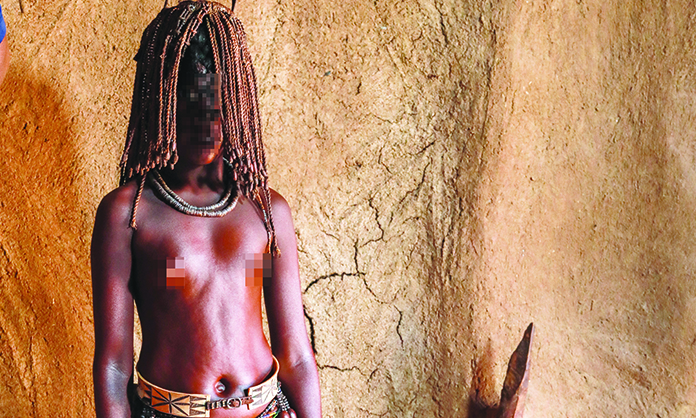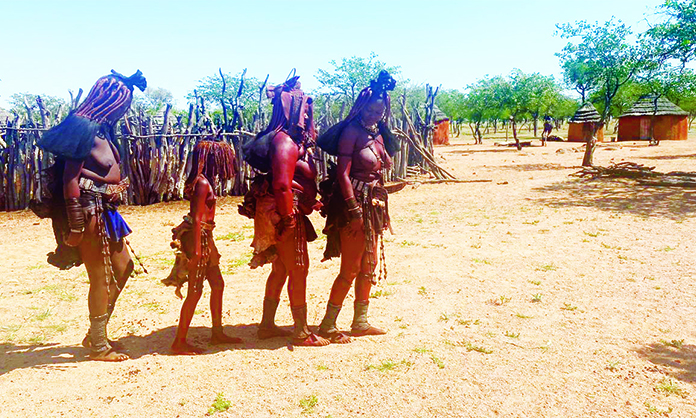Several regions still handing over children in marriage
The veiled 12-year-old bride sits next to her new mother-in-law, surrounded by other women and girls from the Himba village called Otjikandero.
The young bride’s face is covered with a traditional veil made out of ropes bound together at the top of her head.
Neither her eyes, ears, nose or mouth are visible.
She quietly sits next to her new ‘mother’.
The child bride, who is from another village, is to stick to the matriarch’s right-hand side for the next six months to a year.
Her husband, who is not present, is her age.
“Yes, she is about to get married. The Himba people can traditionally get married from two years onwards,” tour guide Gottfriet Ekandjo says.
Ekandjo took a group of media representatives to the village, a popular tourist attraction 20km from Kamanjab, earlier this month.
Ovahimba girls and women between the ages of 16 and 50 gathered in a semicircle to explain the practice of child marriage, which Ekandjo, who has been in the tourism business for the past 26 years, translated.
“But if she gets married while she’s young, she’s not going to have sexual relationships with the husband.
“This husband should take care of this lady or this child until she becomes a lady. And then they will start to engage in sex,” the women said.
They were adament that child marriage is part of Himba culture, which not everyone understands.
“From two years onwards the elders can arrange a marriage,” Ekandjo explained.
He confirmed that the 12-year-old girl’s union was arranged.
She has to wear the veil until the village knows her well enough, he said.
“She wears it until she’s used to everyone at the village. It takes between six months to a year, then she can remove it,” he said.
“Age doesn’t matter,” Ekandjo said regarding the girl’s husband’s age.
A dowry is paid for the union.
“They do pay. The husband’s parents give cattle that will be slaughtered at the village, and two more head of cattle to be paid to the bride’s parents,” he said.

Photo: Ministry of Information, Communication and Technology.
BETROTHED … From as young as two years, girls in the Ovahimba community can be married to a man, but this does not mean they will have any sexual rela- tions, because that part is only introduced once she enters puberty. Child marriage in Namibia is an illegal act.
ILLEGAL
Child marriage in Namibia is illegal in terms the Child Care and Protection Act 3 of 2015.
This prohibition applies to civil, customary and religious marriages.
Despite this, a recent report on child marriage in Namibia reveals that the highest prevalence of child marriage among girls was reported in the Kavango regions at 39,7%, followed by the Kunene region with 24%.
Kamanjab is in the Kunene region.
CONTEXT
Popular Democratic Movement (PDM) member of parliament Vipuakuje Muharukua who is from the Ovahimba community, says he has seen their children on the streets, since child marriage declined.
“You have to realise two things about the Himba people: We do not have street kids. Yes, lately because there’s no more child marriage. The practice is not rife any longer.
“Secondly, the Himba people do not have children out of wedlock. Every child in the Ovahimba community had a father, and that is owing to child marriage,” he says.
Muharukua says a young or unborn girl would be promised to a man and married at the age of one or two.
The marriage needs to take place at a very young age, he says.
“When this child is born, she is known to be a man’s wife. Usually the man’s mother would be a sister of the wife’s father. The child bride’s mother-in-law would also be her father’s sister – an aunt,” he says.
He says the aunt would take the child bride to her husband’s house at that young age, where she would then grow up.
“She would grow up there, not as a wife to someone, she would grow up among other kids in the house.
“She would play with the others. There is nothing sexual that would happen between the would-be-husband and that girl,” he says.
The member of parliament, however, says this ‘safety net’ practice of child marriage is not needed any more.
CONDEMNED
The Ministry of Gender Equality, Poverty Eradication and Social Welfare on Friday condemned the 12-year-old’s marriage.
“The ministry furthermore condemns any form of child marriage as it goes against the principles of child protection and welfare.
“We are committed to upholding the provisions of the Child Care and Protection Act to ensure children are protected from harmful practices like early marriage,” ministry spokesperson Lukas Haufiku said.
The ministry said child marriage is a violation of these rights as it could have severe negative impacts on the physical, emotional and psychological development of minors.
“These cultural practices, coupled with gender inequality and poverty, create a challenging environment in which young girls are disproportionately affected by child marriage, lacking agency and often being married off without their consent,” Haufiku said.
The ministry encourages communities to report cases of child marriage.
“… Along with any other instances infringing on children’s rights within communities, recognising its pivotal role in intervention and follow-up endeavours.
“Our approach to addressing child marriage involves raising awareness about its detrimental effects, providing support services to at-risk children and families and collaborating with community leaders to promote alternative practices that prioritise the well-being of children,” he said.
A recent African Peer Review Mechanism report raised concern over child marriage and teenage pregnancy resulting in a high school dropout rate – especially in rural areas.
The report highlighted communities in the Kavango and Kunene regions as dropout hotspots.
The report states that poverty, culture and tradition, early sexual debut, teenage pregnancy, alcohol abuse and a lack of education opportunities were identified as key drivers of child marriage in Namibia.
The ministry’s child marriage report says these cases are seldomly presented to authorities.
“In the Kunene region, cases of child marriage and statutory rape were not being reported as they often happen between close family members.
“Even when such cases come to light, law-enforcement structures tend to be lenient due to officers’ own traditional grounding,” the report reads.
ANTI-CHILD MARRIAGE LAWS
Ombudsman Basilius Dyakugha on Friday said harmful cultural practices should be done away with.
“The Child Care and Protection Act puts the age of maturity at 18. They specify that a child will be a major once they reach 18 years. They can now do what they want in terms of their body,” he said.
The ombudsman also referred to the Combating of Rape Act, which criminalises sexual activities with a minor under the age of 14.
THE STATS
According to data from the Namibia Demographic and Health Survey in 2013, the prevalence of child marriage among women in Namibia was 18,4%, while this was considerably lower for boys at 4,1%.
By region, the highest prevalence of child marriage among women was reported in the Kavango region at 39,7%, while the Kunene region stood at 24%, the Zambezi at 23,8%, the Omaheke region at 23%, and Otjozondjupa at 22,6%.
The practice was the least prevalent in Oshana at 7%.
There are more child marriages in rural areas (22%) than urban areas (15%).
Statistically significant associations were found between child marriage and place of residence, wealth index, home language, church denomination, employment status, occupation, educational and literacy level.
Stay informed with The Namibian – your source for credible journalism. Get in-depth reporting and opinions for
only N$85 a month. Invest in journalism, invest in democracy –
Subscribe Now!






